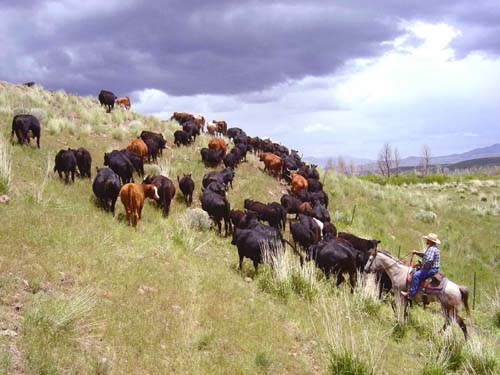
I wrote previously about Cattle Behavior. Here more information.
1) Move the cattle slowly.
– The famous quote is “the only way to work cattle quickly is slowly”. Patience is a virtue when working cattle.
– Putting excessive or inappropriate pressure on the cows usually causes them to NOT do what we intended.
– When you see a cowboy “correcting” a problem it almost always was originally caused by human error.
2) Work from the front to draw cattle to you.
– It is a lot easier to draw cattle where you want them to go than to push them.
– Move in and out of their flight zone and point of balance to get them to move.
– You can create herd movement by going to the side and slightly behind the first few cows. Move into their flight zone behind their point of balance and they will move forward and the rest of the cows behind them will follow.
– If you have to be behind a cow to get it to move assume a position off to either side and behind their point of balance (shoulder).
3) Apply pressure when cattle have a place to go.
– Low stress cattle handling is NOT about handling cattle with no pressure. In fact the success of handling cattle correctly depends on knowing when and where to apply pressure and how much pressure to apply.
– The other key component is setting the cattle up to go where you want them to go before you apply pressure.
– Just as important is to release the pressure as soon as the desired result is achieved. Animals learn desired behavior from when the pressure is released, not from when it is applied.
– Move slowly and if you feel you inadvertently caused movement back off and try again this time more aware of that cow’s zones.
4) Work in triangles.
– Sounds odd but it works
– Move forward or backwards depending on what action you want, and then from side to side so they aren’t turning around to look at you.
5) Going with the flow slows them down or stops their movement.
– Sounds counter intuitive but it’s true. If you are riding closely on the side of a line of cows as you are behind each cow’s point of balance it will move forward but once you pass forward of the shoulder they will slow down. I’ve seen an entire herd come to a stop just because a cowboy was trying to get to the front of the herd.
– If you need to get past cows moving forward you should move quite a ways away from the herd so they won’t slow down as you pass.
6) Going against the flow initiates or accelerates their movement.
– If you are moving past a line of cows going towards the rear they will speed up as you get past their shoulder.
– Sometimes you can use both of these tendencies to your advantage.
7) Cattle work best when they are ready.
– Cattle (like husbands) are not mind readers.
– You have to teach, condition and prepare them.
– That simply means stockmen need to spend time with their cows just getting them use to movement and handling.
– All cows will be required to be handled, often in chutes, during their lives. Gently teaching them about that early in life makes every other situation easier.
8 Keep calm.
– All grazing animals are visual beings that are motivated by fear.
– Yelling and whistling at the animals raises their heart rate more than the sound of a gate slamming.
– Grazing animals are extremely sensitive to rapid sudden movement. People who wave their arms and make sudden jerky movements scare cattle (and reduce profits). Slow steady movements are less likely to trigger a fear reaction
– Cattle will often balk and refuse to walk over a shadow, puddle or change in flooring surface. A coffee cup on the floor or a small chain that jiggles on a fence will make them stop or run away in a panic. If they sudden stop look carefully at what may be scaring them. Something like a jacket flung over a fence is enough to bother a cow.
9) Good cow working skills require time and effort.
– When you are starting out watch what the other cowboys are doing and copy it when appropriate.
– Really try to “be present” and pay attention to what the cows are doing. This is serious work (and money to the family). Remember you are “riding for the brand” which means you treat the cows as though they were your own.
– Don’t think that it’s a herd, think they are a collection of unique individual cows.
– If you are working a herd and one or a few cows take off or go the wrong direction remember that your primary duty is to stay with the herd. That’s where most of the cows (and money!) are. Communicate with someone else and between you decide who will go and who will stay.
– Do less rather than more. The tendency for beginners is to over do it.
– NEVER ride through the herd because as we know it will usually stop or change direction. Instead go off to the side and ride to the front or back as appropriate. If you want to go to the other side go around the back, not the front.
– Be super careful around bulls. They can really hurt you and your horse if angered.
– And be careful around mother cows with calves. They can be very protective so give them lots of space and time.
– Cow work can be done from horseback, ATV or on foot. The same principles apply but the cows usually have to be taught about each situation because they won’t necessarily transfer their past learning.
